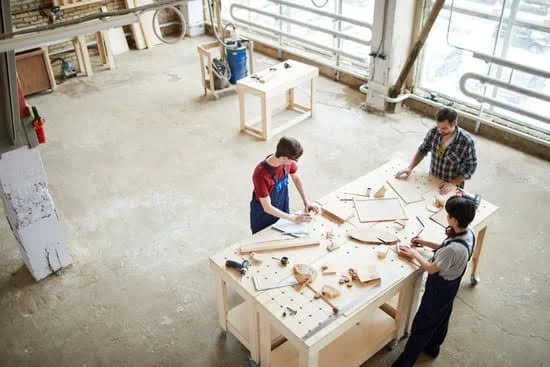Are you passionate about woodworking and looking for ways to turn your hobby into a profitable venture? If so, you’ve come to the right place. In this article, we will explore the art and business of miniature woodworking, and provide valuable insights on how to make money with this intricate craft.
Miniature woodworking is not only a creative outlet but also a potentially lucrative business opportunity. From crafting delicate furniture pieces to tiny decorative items, there is a high demand for finely detailed miniatures in the market. This section will serve as an introduction to the world of miniature woodworking, highlighting the potential for profitability and success in this specialized niche.
We will delve into the essential tools and materials needed to start your own miniature woodworking business, as well as offer guidance on choosing the right projects that have the potential to generate substantial profits. Additionally, we’ll discuss effective marketing strategies, pricing techniques, and sales channels that will help you establish a strong online presence and attract customers.
Whether you’re an experienced woodworker or just starting out, this comprehensive guide will equip you with the knowledge and resources needed to thrive in the world of miniature woodworking.
Getting Started
Miniature woodworking is a unique and sought-after craft that has the potential to be a profitable business venture. However, before diving into the world of creating tiny, intricate woodwork, it’s important to have the essential tools and materials at your disposal. Without the right equipment, it can be challenging to produce high-quality miniature woodworking pieces that will attract customers.
When getting started with miniature woodworking, one of the most crucial tools you’ll need is a set of precision hand tools. These include small chisels, carving knives, and files that are designed specifically for working with delicate pieces of wood. Additionally, investing in a quality miniature saw and sanding tools can make the process much smoother and more enjoyable. It’s also important to have a reliable work surface and clamps to secure your projects while working on them.
In terms of materials, selecting the right type of wood is key to producing stunning miniature woodworking creations. Basswood and micro-lumber are popular choices due to their fine grain and ease of carving.
It’s also helpful to have a variety of finishes and adhesives on hand to add that perfect final touch to your pieces. Understanding how each material works and how they complement each other is essential in creating visually appealing and marketable products for potential buyers who are interested in how to make money with miniature woodworking
Choosing the Right Projects
Miniature woodworking offers a wide range of creative possibilities, but not all projects are equally profitable. Choosing the right projects is essential for success in this niche. Here are some tips on identifying profitable miniature woodworking ideas.
Researching Trends and Demand
Before starting a new project, it’s important to research current trends and demand in the market. Look for popular themes and styles that are in high demand among collectors and enthusiasts. This might include miniatures of furniture, household items, or even realistic replicas of famous landmarks.
Understanding Your Target Audience
Identifying your target audience is crucial when selecting projects. Consider who will be interested in purchasing your miniature woodworking creations. Are you targeting collectors, hobbyists, or those looking for unique home decor pieces? Understanding your audience will help you tailor your projects to meet their specific preferences and needs.
Assessing Profit Margins
Not all miniature woodworking projects will have the same profit potential. Assess the costs involved in materials and labor for each project, as well as the potential selling price. It’s important to choose projects that offer a good profit margin while still being appealing to your target market.
By carefully researching trends, understanding your audience, and assessing profit margins, you can identify profitable miniature woodworking ideas that will help you make money with this creative craft.
Marketing Your Miniature Woodworking Business
When it comes to making money with miniature woodworking, having a strong online presence is crucial for reaching potential customers and growing your business. In today’s digital age, the internet provides countless opportunities to showcase and sell your miniature woodworking creations to a global audience. Here are some key strategies for building a robust online presence for your miniature woodworking business.
Creating a Professional Website
One of the first steps in establishing your online presence is creating a professional website to showcase your miniature woodworking products. Your website should feature high-quality images of your creations, detailed product descriptions, pricing information, and an easy-to-use e-commerce platform for selling your items directly to customers. It’s also important to ensure that your website is mobile-friendly and optimized for search engines to attract organic traffic.
Social Media Marketing
Utilizing social media platforms can be an effective way to market your miniature woodworking business and connect with potential customers. Establishing a presence on popular platforms such as Instagram, Facebook, and Pinterest can help you engage with a broader audience, share behind-the-scenes glimpses of your creative process, and promote special offers or new product launches. Engaging with followers through captivating visual content can help build brand awareness and drive traffic to your website.
Utilizing Online Marketplaces
In addition to having your own website, leveraging established online marketplaces such as Etsy, eBay, or Amazon Handmade can expand the reach of your miniature woodworking business. These platforms provide access to millions of potential customers who are specifically seeking handmade and unique products. By listing your items on these marketplaces, you can benefit from their built-in traffic and customer base while still maintaining control over pricing and branding.
By implementing these strategies for building a strong online presence, you can effectively market your miniature woodworking business and increase the likelihood of generating sales and revenue. A well-executed online presence not only helps establish brand credibility but also positions your business for long-term success in the competitive world of e-commerce.
Setting Your Prices
When it comes to determining the value of your miniature woodworking creations, several factors come into play. One of the most important considerations is the time and effort you put into each piece. Consider how many hours it took to design, cut, carve, and finish the piece, and factor in the cost of materials used as well. It’s essential to price your work in a way that reflects its quality and craftsmanship while also remaining competitive in the market.
Another crucial factor in pricing your miniature woodworking creations is understanding your target audience. Are you catering to collectors who are willing to pay a premium for unique, high-quality pieces? Or are you targeting a broader audience looking for affordable yet well-crafted items? By identifying your ideal customer base, you can tailor your pricing strategy to match their purchasing power and preferences.
In addition to considering craftsmanship and target audience, research plays a key role in setting the prices for your miniature woodworking creations. Look at what similar pieces are being sold for in online marketplaces or at craft fairs.
This will give you an idea of the current market rates and help you position your products competitively. Keep in mind that as you gain more experience and recognition in the industry, you can gradually increase your prices to reflect your growing expertise and brand reputation.
| Factor | Consideration |
|---|---|
| Time & Effort | Calculate hours spent on each piece |
| Target Audience | Identify ideal customer base & their purchasing power |
| Market Research | Analyze competitive pricing & current market rates |
Selling Your Work
Once you have completed your miniature woodworking projects, the next step is to explore different sales channels to effectively market and sell your creations. There are several avenues through which you can showcase and sell your work, allowing you to reach a wider audience and maximize your earning potential.
One of the most popular sales channels for miniature woodworking is through online platforms such as Etsy, eBay, and even Amazon Handmade. These websites provide a global marketplace for artisans and crafters to display and sell their handmade items. Setting up an online store on these platforms allows you to reach customers from all over the world, increasing the exposure of your miniature woodworking business.
In addition to online sales channels, participating in craft fairs, artisan markets, and trade shows can also be an effective way to sell your miniature woodworking creations. These events allow you to interact with potential customers directly, showcase the quality of your workmanship, and receive immediate feedback. Building a network within the local crafting community can also lead to collaboration opportunities and access to new customer bases for your business.
| Sales Channel | Advantages |
|---|---|
| Online Platforms (Etsy, eBay, Amazon Handmade) | Global reach and exposure |
| Craft Fairs/Artisan Markets/Trade Shows | Direct interaction with customers; networking opportunities |
Building a Brand
- Define Your Brand Identity: Determine what sets your miniature woodworking business apart from others. Consider factors such as the style of your creations, your target market, and the values that drive your business.
- Create a Memorable Logo and Visual Identity: Develop a logo and visual elements that represent your brand effectively. This could include color schemes, typography, and imagery that align with the personality of your business.
- Tell Your Story: Share the story behind your miniature woodworking business and what inspires your creations. Customers are often drawn to brands with authentic stories and a personal touch.
- Consistent Branding Across Platforms: Ensure that your brand identity is consistent across all platforms, including your website, social media profiles, packaging, and marketing materials.
- Engage with Your Audience: Build relationships with your customers by engaging with them on social media, responding to inquiries promptly, and showing appreciation for their support.
By investing time and effort into building a strong brand for your miniature woodworking business, you can position yourself as a reputable and distinctive presence in the market.
Ultimately, creating a unique identity for your miniature woodworking business is essential for attracting customers and standing out in a competitive market. Whether through storytelling or consistent branding across platforms, building a strong brand sets the stage for success in both online and offline sales channels.
Scaling Your Business
Expanding and scaling your miniature woodworking business can be an exciting yet challenging endeavor. As you look to grow your enterprise, there are several key tips and strategies that can help you achieve success in this competitive market.
Here are some essential tips for growing and expanding your miniature woodworking business:
1. Diversify Your Product Line: One way to expand your business is by diversifying your product line. Consider creating a range of miniature woodworking items, from furniture to decor pieces, to appeal to a broader customer base.
2. Collaborate with Other Artisans: Partnering with other artisans, such as metalworkers or glassblowers, can provide opportunities for creating unique and complementary products. This collaboration can also open doors for joint marketing efforts and reaching new audiences.
3. Attend Trade Shows and Craft Fairs: Participating in trade shows and craft fairs can expose your business to a larger audience and potential customers. These events also provide networking opportunities with other businesses in the industry.
4. Offer Customization Services: Providing customization services for your miniature woodworking products can attract higher-paying customers who are willing to pay a premium for personalized items.
5. Expand Your Online Presence: Invest in e-commerce platforms and social media marketing to reach a wider audience beyond your local market. Establishing an online store can significantly increase sales potential.
By implementing these growth strategies, you can position your miniature woodworking business for long-term success in the industry while increasing profitability.
Conclusion
In conclusion, the world of miniature woodworking offers endless opportunities for creative expression and financial gain. By honing your skills, identifying profitable projects, and effectively marketing your creations, you can indeed make money with miniature woodworking. With the right tools, materials, and pricing strategy, you can establish a successful business in this niche market.
As the demand for unique and artisanal products continues to rise, there is a growing appreciation for the craftsmanship and artistry involved in miniature woodworking. By building a strong online presence and leveraging different sales channels, such as craft fairs, online marketplaces, and social media platforms, you can reach a wider audience and maximize your earning potential.
Furthermore, by creating a unique brand identity and constantly evolving your skills and offerings, you can position yourself as a leader in the miniature woodworking industry. As you scale your business and explore new opportunities for growth and expansion, you will find that the future of miniature woodworking is indeed bright as a profitable venture. Embrace the endless possibilities that this niche market has to offer and watch your passion for woodworking translate into a successful and rewarding business.
Frequently Asked Questions
What Type of Woodworking Makes the Most Money?
The type of woodworking that typically makes the most money is custom furniture making. Creating unique, high-quality pieces can command higher prices and attract wealthier clientele who are willing to pay for custom craftsmanship.
Can You Really Make Money Woodworking?
Yes, it is possible to make money through woodworking. However, success in this field requires a combination of skill, creativity, and good business sense. Being able to produce quality products efficiently and market them effectively is key.
Is Custom Woodworking Profitable?
Custom woodworking can be profitable for skilled craftsmen who are able to produce high-quality, unique pieces. By catering to specific customer needs and preferences, woodworkers can command higher prices for their customized work compared to mass-produced items. Building a reputation for excellence in custom woodworking can also lead to repeat business and referrals.

Hi everyone! I’m a woodworker and blogger, and this is my woodworking blog. In my blog, I share tips and tricks for woodworkers of all skill levels, as well as project ideas that you can try yourself.





